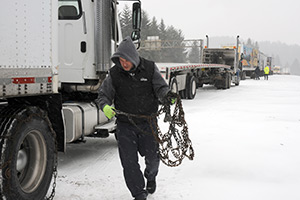In Transportation, Rising Profits Don’t Lift All Workers’ Boats

Big business is getting bigger, and workers’ slice of the economic pie is getting smaller, especially in the transportation and warehousing sector.
In transportation and warehousing, the 50 biggest companies increased their share of revenue by more than 11 percentage points from 1997 to 2012; yet workers’ share of the value added by the sector fell 7.6 percentage points from the 1998-1999 average to the 2013-2014 average.
The sector includes railroads and airlines, industries where a series of blockbuster mergers concentrated ownership at the top. Lee Klaskow, who follows railroads for Bloomberg Intelligence, says they have become “extremely profitable.” Workers tend to be well-paid, but there are fewer of them, reducing labor’s share of income, he said.
At the other end of the concentration scale, there was a slight decline from 1997 to 2012 in big companies’ domination of the health care and social assistance sector. There was a corresponding increase in the share of the value added in the industry going to labor, fitting the pattern Feroli noted.
Those trends have bred resentment toward large corporations. Now research shows a surprisingly tight link between the two phenomena: The share of the pie that goes to workers has been shrinking most in precisely those industries where ownership is becoming more concentrated.
Increasing industry concentration “may explain one of the transcendent issues confronting the U.S. economy,” namely labor’s declining share and profits’ rising share of the value a company creates, Michael Feroli, the chief U.S. economist at JPMorgan Chase, wrote in an April 25 research note. In an interview four days later, Feroli said that while the finding needs closer analysis, “I haven’t had anyone say, ‘You’re obviously missing something.’ "
The work of Feroli and his team impresses Jason Furman, chairman of the president’s Council of Economic Advisers. “I think it’s great there’s more of a debate about concentration and its impacts on the economy,” he says. Feroli and fellow economists tapped new data that Furman’s group generated for an “issue brief” last month. From 1997 to 2012, the report said, the 50 largest companies in many sectors sharply increased their share of industry revenue.
Feroli’s team lined up those numbers against new data from the Department of Commerce’s Economic Census, which shows the value added by each industry—i.e., the amount of money the sector receives for its products or services minus the cost of inputs such as parts, raw materials, and energy. The value that the sector adds is split among workers (wages and salaries), government (taxes), and “surplus,” which includes profit for shareholders. The share workers got tended to decline in industries where there’s more consolidation.
What accounts for the pattern? Feroli doubts the theory that industries with greater concentration can pay lower wages because fewer companies are competing for talent. If companies in one sector tried to underpay, their workers would switch to other sectors over time, he says.
A more likely explanation, Feroli says, is that industries with more concentrated ownership can charge higher prices. They pay out their extra profits to shareholders, or to the government in taxes, but not to workers. The question is why the companies have felt so little pressure to share the bounty with their workers. Economists cite the decline in unions and employees’ fears, stemming from the last recession, that they could be replaced if they complain. One hopeful sign for workers: The share of national income going to wages and salaries has rebounded since 2012, erasing about 30% of its post-1997 decline.

